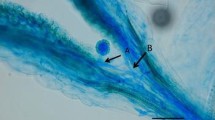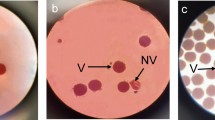Summary
A study of pre- and post-fertilisation barriers after interspecific crosses of diploid and tetraploid Trifolium pratense L. and wild species T. alpestre L., T. medium L. and T. sarosiense Hazsl. was aimed at finding of a promising cross combination for obtaining hybrids. The growth of pollen tubes was arrested in interspecific crosses mainly when T. pratense was at a diploid level. To investigate the post-fertilisation barriers in detail, the hybrid embryo viability was traced by two clearing treatments of immature seeds: (1) using chloral hydrate (which proved to be most appropriate); and (2) a mixture of benzyl benzoate and dibutly phthalate. In interspecific combinations T. pratense (4×) × either T. alpestre or T. sarosiense, enlargement of immature seeds occurred, but no hybrid embryo was traced. Of the wild species used as a male parent for crosses, T. medium was the only exception from the point of view of fertilisation. Globular, heart and the early torpedo stages of hybrid embryos were observed 7 days after pollination (DAP) but only when T. pratense was at a tetraploid level. When T. pratense (2×, 4×) was used as a male parent for interspecific crosses with T. alpestre, T. medium and T. sarosiense, strong defects in various stages of embryogenesis were observed, particularly wrinkled and narrowing embryo sacs caused by an expansion of endothelial cells. We conclude with the following finding: (1) to make crosses only in one direction with T. pratense as a female parent and T. medium as a male; (2) to use tetraploid plants of T. pratense; (3) and to excise hybrid embryos at an early torpedo stage, about 7 DAP.
Similar content being viewed by others
References
Aida, M., T. Ishida, H. Fukaki, H. Fujisawa & M. Tasaka, 1997. Genes involved in organ separation in Arabidopsis: analysis of the cup-shaped cotyledon mutant. Plant Cell 9: 841–857.
Algan, G. & H.N. Bakar, 1996. Light and electron microscopic examination of the embryo and endosperm development in the natural tetraploid Trifolium pratense L. Israel J Plant Sci 44: 273–288.
Bharathi, M., P.B. Kirti, U.R. Murty & N.G.P. Rao, 1982. Occurrence of atypical embryo-sac like structures in Arachis glabrata Benth. Curr Sci 51: 612–612.
Christiansen, P., J.M. Gibson, A. Moore, C. Pedersen, L. Tabe & P.J. Larkin, 2000. Transgenic Trifolium repens with foliage accumulating the high sulphur protein, sunflower seed albumin. Transgen Res 9: 103–113.
Collins, G.B., N.L. Taylor & G.C. Phillips, 1981. Successful hybridization of red clover with perennial Trifolium species via embryo rescue. In: Proc XIV Int Grassl Congr. Lexington, pp. 168–170.
Fehr, W.R., 1987. Principles of cultivar development. Vol. 1 Theory and technique. McGraw Hill, New York.
George, G.P., R.A. George & J.M. Herr Jr., 1979. A comparative study of ovule and megagametophyte development in field-grown and greenhouse-grown plants of Glycine max and Phaseolus aureus (Papilionaceae). Amer J Bot 66: 1033–1043.
Hendrych, R., 1990. The third series of complement on Trifolium – monograph by Zohary and Heller (Plantae hybridae). Preslia, Praha 62: 43–60.
Herr, J.M., 1982. An analysis of the methods for permanently mounting ovules cleared in four-and-half type clearing fluids. Stain Technology 57: 161–169.
Herr, J.M., 1999. Endosperm development in Arabidopsis thaliana (L.) Heynh. Acta Biologica Cracoviensia 41: 103–109.
Hoshino, Y., E. Nishino & M. Mii, 2000. Isolation of embryo sacs from Dianthus ovules by enzymatic treatment and microdissection. Plant Cell Rep 19: 443–447.
Hughes, J.W., 1986. Tissue culture derived crossing barriers. Amer J Bot 73: 323–329.
Huyghe, C., 1987. A cytological and physiological study of haploid-diploid polyembryony in flax (Linum-usitatissimum L.). Agronomie 7: 567–573.
Kazimierska, E.M., 1978. Embryological studies of cross compatibility in the genus Trifolium L. I. Hybridization of T. pratense L. with some species in the subgenus Lagopus Bernh. Genet Pol 19: 1–12.
Kazimierska, E.M., 1980. Embryological studies of cross compatibility of species within the genus Trifolium. L. III. Development of the embryo and endosperm in crossing T. repens L. with T. hybridum L. and T. fragiferum L. Genet Pol 21: 37–61.
Kazimierski, T., E.M. Kazimierska & Cz. Strzyzewska, 1972. Species crossing in the genus Trifolium. Genet Pol 13: 11–32.
Lee, R.W.H., J. Strommer, D. Hodgins, P.E. Shewen, Y. Niu & R. Lo, 2001. Towards development of an edible vaccine against bovine pneumonic pasteurellosis using transgenic white clover expressing a Mannheimia haemolytica A1 leukotoxin 50 fusion protein. Infect Immun 69: 5786–5793.
Mackiewicz, T., 1965. Low seed-setting in tetraploid red clover (Trifolium pratense L.) in the light of cytoembryologic analyses. Genet Pol 6: 5–39.
Mayer, U., G. Buettnet & G. Jurgens, 1993. Apical-basal pattern formation in the Arabidopsis embryo studies on the role of the gnom gene. Development 117: 149–162.
Merker, A., 1984. Hybrids between Trifolium medium and T. pratense. Hereditas 101: 267–268.
Merker, A., 1988. Amphidiploids between Trifolium alpestre and T. pratense. Hereditas 108: 267.
Morris, J.B. & S.L. Greene, 2001. Defining a multiple-use germplasm collection for the genus Trifolium. Crop Sci 41: 893–901.
Nedbalkova, B., J. Repkova & L. Bartosova, 1995. Germplasm TBZP1, TBZP2, TBZP3, TBZP4 of interspecific Trifolium hybrids. Scientific Studies – Research Institute for Fodder Plants, Ltd. Troubsko 13: 129–131.
Phillips, G.C., G.B. Collins & N.L. Taylor, 1982. Interspecific hybridization of red clover (T. pratense L.) with T. sarosiense Hazsl. Using in vitro embryo rescue. Theor Appl Genet 62: 17–24.
Phillips, G.C., J.W. Grosser, S. Buger, N.L. Taylor & G.B. Collins, 1992. Interspecific hybridization between red clover and Trifolium alpestre using in vitro embryo rescue. Crop Sci 32: 1113–1115.
Pittock, C., J.J. Weinman & B.G. Rolfe, 1997. The activity of a tobacco basic chitinase promotor in transgenic white clover provides insights into plant development and symbiosis. Aust J Plant Physiol 24: 555–561.
Quesenberry, K.H., D.S. Wofford, R.L. Smith, P.A. Krottje & F. Tcacenco, 1996. Production of red clover transgenic for neomycin phosphotransferase II using Agrobacterium. Crop Sci 36: 1045–1048.
Ramsay, G., & B. Pickersgill, 1986. Interspecific hybridization between Vicia faba and other species of Vicia – approaches to delaying embryo abortion. Biol Zbl 105: 171–179.
Sawai, A. & S. Ueda, 1987. Embryo development of the hybrid of Trifolium medium L. × 4 x Trifolium pratense L. J Jpn Soc Grassl Sci 33: 157–162.
Sawai, A., S. Ueda, M. Gau & K. Uchiyama, 1990. Interspecific hybrids of Trifolium medium L. × 4x T. pratense L. obtained through embryo culture. J Jpn Soc Grassl Sci 35: 267–272.
Schwer, J.F. & R.W. Cleveland, 1972. Tetraploid and triploid interspecific hybrids of Trifolium pratense, T. diffusum and some telated species. Crop Sci 12: 419–422.
Scott, A., D. Woodfield & W.R. White, 1998. Allelic composition and genetic background effects on transgene expression and inheritance in white clover. Mol Breed 4: 479–490.
Sharma, S.B., K.R. Hancock, P.M. Ealing & D.W.R. White, 1998. Expression of a sulfur-rich maize seed storage protein, delta-zein, in white clover (Trifolium repens) to improve forage quality. Mol Breed 4: 435–448.
Stelly, D.M. & S.J. Peloquin, 1983. Methods to detect 2n female gametophytes in Solanums. Amer Potato J 60: 821–821.
Taylor, N.L., R.F. Quarles & M.K. Anderson, 1980. Methods of overcoming interpecific barriers in Trifolium. Euphytica 29: 441–450.
Taylor, N.L. & K.H. Quesenberry, 1996. Red clover science. Kluwer Acad Publ, Dordrecht Hardbound, pp. 170–187.
Vogt, M. & W. Schweiger, 1983. Study of the methodology of embryo culture in Trifolium. Arch Zücht-Forsch, Berlin 13: 273–283.
Author information
Authors and Affiliations
Corresponding author
Rights and permissions
About this article
Cite this article
Repkova, J., Jungmannova, B. & Jakesova, H. Identification of barriers to interspecific crosses in the genus Trifolium . Euphytica 151, 39–48 (2006). https://doi.org/10.1007/s10681-006-9126-3
Received:
Accepted:
Published:
Issue Date:
DOI: https://doi.org/10.1007/s10681-006-9126-3




